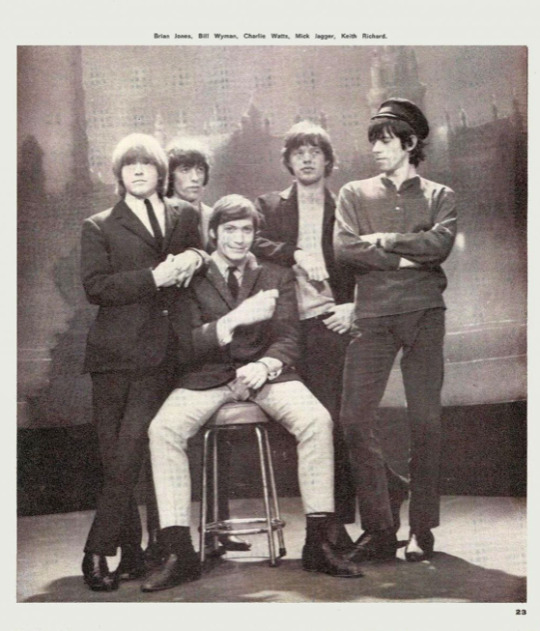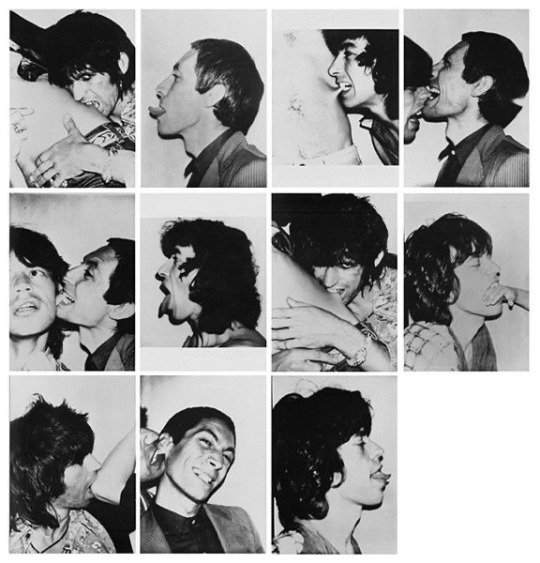#Mick is judging Keith for being That Way about Charlie
Text

#this is it#this is the distillation of the dynamic#Brian is posing (as always)#Charlie is happy to be there and doing his job as best he can#(Also where he belongs at the very center of the band)#Keith is absolutely livid someone else is touching Charlie#Mick is judging Keith for being That Way about Charlie#and Bill is clueless and exiled to the back#the rolling stones#charlie watts#keith richards#mick jagger#young married band#bill wyman#brian jones
22 notes
·
View notes
Text

The Rolling Stones by Andy Warhol
#yes i’m still thinking about this#so my favorite bites (even if no one asked)...#ok top 3#3) mick biting charlie’s ear: SO ARTSY they really sold it way more than when it was the other way around.... love it.. well executed 7.5/10#2) charlie biting micks nose: YES?? chalrie really brought something cool to the table love what they did here.. the teamwork was great 8/10#1) THE SEOCND ONE OF KEIRTH BRIITNG THE STOMSCH????? HOTTTTT!! HOT /&&;;!!! HIS EYES AND THE GRASP 194848/10... objectively of course#ok for bottom 3#3) the one of just bill.... who tf cares#2) the one of bill biting someoens stomach...?? why is it so stretchy???? i mean keith just did it so well and he did it so not... nope 2/10#oh did i say bottom 3 i meant 2#and that was my audition for being atm judge#the rolling stones#scans#keep
51 notes
·
View notes
Text
No Stones Unturned: Brian Jones
Brian Jones
The idea for the Rolling Stones as a band came from the mind of Brian Jones. He was living in London at the time playing locally with other musicians like Alexis Corner, future Manfred Mann singer Paul Jones, and Cream bassist, Jack Bruce. He really embraced the blues, even learning to play slide guitar for a time. His stage name in the beginning was Elmo Lewis. In May 1962, he placed an advertisement in the Jazz News announcing an audition for a new R&B group at the Bricklayers Pub. As noted previously, Ian Stewart was the first future member to respond to the advertisement, and later Mick Jagger would join the band. He would also introduce Keith Richards to the band. Jones was the person, who came up with the name for the band. A journalist was interviewing him over the phone about the band, but he first asked the name. On the floor, there’s sat a Muddy Waters record, which included the song “Rollin’ Stone Blues.”
At the very beginning, Brian Jones acted as the band’s business manager doing what he could to get gigs for the group. Charlie Watts would say later, “Brian was very instrumental in pushing the band at the beginning. Keith and I would look at him and say he was barmy. It was a crusade to him to get us on the stage in a club and be paid half-a-crown and to be billed as an R&B band.” In this role, Jones took it upon himself to receive £5 more than others in the band. As other members found this out, they did not really agree with it. They were also surprised to learn that Jones acted as the unquestioned leader of the band.
People tend to forget that Brian Jones was a gifted musician. He stood out as probably one of the most versatile instrumentalists the band ever had. He could play a multitude of different instruments besides the standard rock band instruments. If one of their songs needed something like a sitar, then chances are Jones was playing it. This can be seen in the song, “Paint It Black.” He played slide guitar on “I Wanna Be Your Man,” organ on “Let's Spend the Night Together,” marimba on “Under My Thumb,” mellotron on “She’s a Rainbow,” saxophone on “Dandelion,” and autoharp on “You Got the Silver.”
Jones also played harmonica on a number of their early tracks including “Come On,” “I Wanna Be Your Man,” “I Just Want To Make Love To You,”It’s All Over Now.” He was the person to teach Mick Jagger to play the harmonica. The musician began to add his backing vocals to several of the songs as well. One of the last ones he ever recorded emerges in “Sympathy for the Devil.”
Jones and Keith Richards also came up with the idea for what was called guitar weaving. This is something they picked up on through listening to Jimmy Reed records. Richards would say in an interview. “We listened to the teamwork, trying to work out what was going on in those records; how you could play together with two guitars and make it sound like four or five.” After Jones’s time in the band came to an end, this method would continue with all the other guitarists that ever played for the Stones. This meant that there was no clear boundary between the rhythm guitarist and the lead guitarist as they switched off, even in the same song.
The arrival of Andrew Oldham Loog signaled the beginning of Brian Jones gradually disconnecting from the rest of the band. Oldham encouraged Mick Jagger to assert himself as the front man, while at the same time Jagger and Richards to write their own songs. More money could be made for the band by doing their own songs, but Jones really preferred to do blues covers. For his part, Oldham also began to take over a large measure of control of the group as far as any management decisions go. According to Oldham, Jones was always a bit of an outsider from the very beginning as he often traveled separately from the group during their first tours. He began to feel less and less as a part of the group because he could not write songs and his management role was essentially taken away. The guitarist soon turned to drugs and alcohol because of all the stress caused by losing control of a band he started. Many people around that time would also describe his personality as either very pleasant or completely antisocial. Nobody knew from one moment to the next which Brian Jones you would be getting.
Tensions between the band members and Jones really reached its boiling point in 1967. His girlfriend Anita Pallenberg, a model, left him for Keith Richards. Three months later he was arrested for drug possession just after the Redlands bust involving Jagger and Richards. Authorities found marijuana, cocaine, and amphetamines. He would only confess to possessing marijuana. Jones had also become increasingly bored with the guitar often looking for more and more exotic instruments to play in songs. Unfortunately, he started becoming only a minor player in the band often skipping recording sessions. The last album that he would take an active part in was Beggars Banquet in 1968. His last appearance with the band was that same year at the Rock and Roll Circus special, which included The Who, Eric Clapton, and John Lennon. One of his most significant contributions musically at this time was not even for the Rolling Stones, but Jimi Hendrix. He would play percussion on the song “All Along the Watchtower.
That same year Jones was arrested for possession of cannabis, which marked the beginning of the end of his time with the band. Although, he only received a fine due to the leniency of the judge, but the band wanted to tour of the United States the following year. The musician would have quite a hard time obtaining a work visa to even go to the United States. He was also in absolutely no condition to participate as a functional band member because of drugs and alcohol. In the recording studio, the band would turn off his amplifier because Jones was usually too intoxicated to play. If he tried playing the harmonica, his mouth would begin to bleed from drug use. The guitarist would not receive a work permit to tour in late 1969, so on the suggestion of Ian Stewart they added another guitarist. In June 1969, Jagger, Richards, and Charlie Watts visited Jones at his home. They informed him that the band would no longer need his services anymore. He was replaced by 20-year-old Mick Taylor formerly of John Mayall’s Bluesbreakers.
In November 1968, Brian Jones had purchased a home in East Sussex called Cotchford Farm. This had been previously owned by Winnie the Pooh author A.A. Milne. Alexis Corner had visited him in June 1969 saying that he seemed to be much happier. Around midnight of July 2-3, he was discovered motionless in the swimming pool. By the time medical personnel could reach him, Jones was pronounced dead. His girlfriend at the time said that when they took him out of the pool, he still had a pulse. The final cause was death by misadventure, the same as the death of Bon Scott of AC/DC years later. The Who’s Pete Townsend wrote a poem dedicated to him, which was published in the Times. Jimi Hendrix dedicated a song to him during an appearance shortly after his death on US television. The Rolling Stones had been scheduled to perform a concert at Hyde Park in order to introduce their new guitarist. They instead decided to dedicate the concert to his memory. Jagger began the concert by reading a poem entitled “Adonis” by Percy Shelly written about his friend John Keats. They then sang a Johnny Winter song, which was one of Jones’s favorites. Bill Wyman and Charlie Watts were the only members of the band to attend his funeral. Mick Jagger said that his contract for the upcoming film Ned Kelly would not allow him to delay the film shoot. Keith Richards did not attend because of their past history. Soon after his death, theories began to pop up from associates of the band that Jones was actually murdered. This would go on for many years, which eventually led to a fictional film being made about it in 2005. In 2009, the case was reopened to see if the cause of death had been murder, but the police at the time found no new information to change that finding.
The legacy of Brian Jones will always be a bit tragic. His death signaled the first one of rock stars dying young, which would be followed by Janis Joplin, Jimi Hendrix, and Jim Morrison. Mick Jagger was asked an interview whether he felt guilty about his death. “No, I don't really. I do feel that I behaved in a very childish way, but we were very young, and in some ways we picked on him. But, unfortunately, he made himself a target for it; he was very, very jealous, very difficult, very manipulative, and if you do that in this kind of a group of people you get back as good as you give, to be honest. I wasn't understanding enough about his drug addiction. No one seemed to know much about drug addiction. Things like LSD were all new. No one knew the harm. People thought cocaine was good for you." Yet, his influence on the legacy of the band cannot be underestimated. Bill Wyman probably said it best in his book. “He formed the band. He chose the members. He named the band. He chose the music we played. He got us gigs.”

0 notes